 |
 |
|
|
|
|
Castle in Zbarazh, September 2009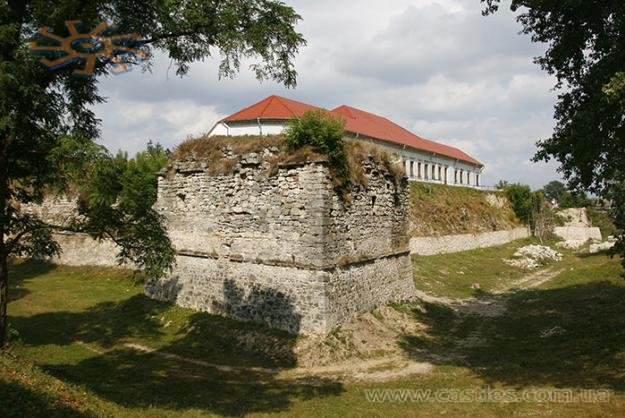 |
The beautiful Castle Palace in Zbarazh. 9 June 2006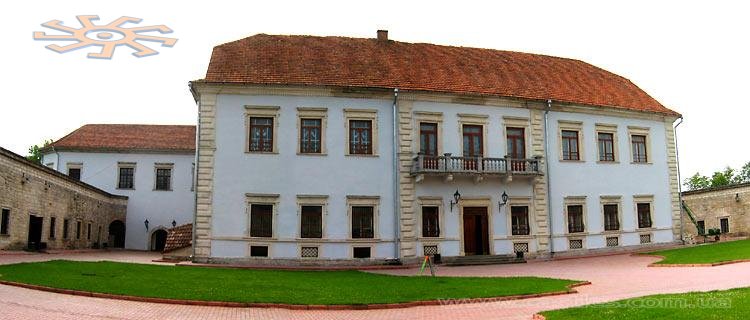 |
Translated by Dictum Factum (Kyiv)
49° 40′ N, 25° 47′ O
This district centre near Ternopil (more exactly - 24 kilometers northeast from region centre) is the excellent example why a decent town should be situated near the decent roads. Several kilometers which separate Zbarazh from the road from Ternopil to Kremenets, determine in this little town everything. Beginning with the buses that go here (horrible outdated Lazys with dusty seats and with a heavy constantly smoker-driver, shaked fixed-route taxis, stuffed with cheerful old ladies) – ending with dull as party newspaper, sleepy bus station, or possibility of hitchhiking or the alternative roads to Kremenets – or the small number of tourists in the town that has such rich history.
Sadly, but what can be done?
This town was firstly mentioned in the chronicles dated 1211 year, but long before that the town on the river Gnizna was one of the most fortified autonomous centers of Galicia-Volyn principality. It is known that in the XIII century it belonged to the Polish king Leszko Bialy (until 1219).
Simply here the castle was built by semi-mythical brothers Zbarascy (Zbaras'ky). When in 1474 Tatar horde wanted to seize the town, citizens of Zbarazh were burned together with the fortress - but not obeyed. For this, the Tatars destroyed the castle completely. Once again, the Tatars destroyed the town in 1598.
Since 1636 Zbarazh belongs to Wiśniowiecki magnates - because a former owner of town Zbaraski had no children, no heirs. The castle was one of the strongest, was armed with 50 guns.

In the rooms of Zbarazh castle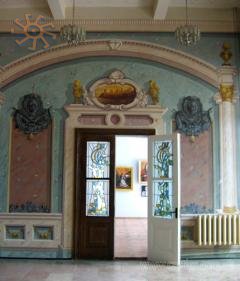 |
It’s then, in the XX century, after two world wars, instead of former castle remained only fragments of the defensive walls and framework of the palace. From the castle’s stones was built farms, in the palace was arranged the palace of pioneers where acted a sports school and various societies. Only in 1994 the complex was recognized as historical and architectural reservation. Soon, in the palace began to work a museum, which I liked so much in 1999 (Entrance ticket in 1999 was worth only 30 (!!!) kopecks! For the collection of Easter eggs! For the sculptures with implements (hoes- shovel, -forks) of Canadian female artists!!!).
However, in 2008 the museum at the castle was almost the most expensive among the likes - entrance ticket was worth UAH8.
Most people the name of Zbarazh associate with “Ogniem i mieczem” by Henryk Sienkiewicz - and Jerzy Hoffman - because right here took place very important events of Cossack liberation war in XVII century: in 1649, Khmelnitsky’s forces laid siege to a strong Polish garrison in Zbarazh. A selected army under the guidance of the king Jan II Kazimier came to help a garrison. The Hetman attacked Poles near Zboriv (it's not far from Zbarazh) and almost took the king captive. But Khmelnitsky’s ally Crimean khan Islam-Girey prevented this fact; he warned that would take part of Jan Kazimier, if Khmelnitsky wouldn’t stop the military operations.
The result of this battle was Zboriv treaty under which the registry Cossack army was reduced from 60 to 40 thousands, Hetman state had Kiev, Chernigov and Bratslav provinces, divided into regiments. Volhyn, Podillya and Polissya passed to Poland. Near the Zbarazh walls died Korsunsky Colonel S. Mrozovitskiy (N. Morozenko), Ivan Bohun was seriously wounded.
In 1707 (or in 1702? Sources don’t know the exact year) had visited Petro I. Together with his friend Ivan Mazepa. They went on meeting with the polish king in Rava Rusk. They wanted even to pass the night here but the reconnaissance reported that nearby are Tatars. The king not dare to stay in Zbarazh and went to Berezhany. What has happened there you can read here. But that is another story. The same as here stayed before Berestetska battle Bohdan Khmelnytsky. 
The bastion is rebuilt. June-2006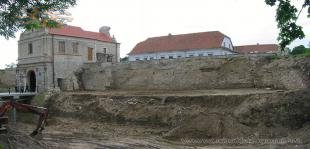 |
I think that is exactly heroic and tragic events of Zbarazhska siege caused such intense interest to the castle from the side of Polish tourists and patrons, and the Ukrainian authorities. Not long ago (spring 2006) former President Viktor Yushchenko visited the town to demonstrate that the provincial museum (such as Zbarazhsky) may compete with the capital's cultural institutions. This example is so perfectly fit into the current trend: let castles and fortresses on hire to those who have money, in order to save.
And it’s true. And Zbarazh castle is an incredibly wonderful example: restoration works perform at full speed, bastions are rebuilt, basements are cleared, expositions of items of consumer goods, weapon and wooden sculptures are arranged…
Zbarazh Castle is the main pearl of National Park “Castles of Ternopil” (Director Matsipura Anatoly Viktorovych). In the plans are restoration works in Terebowlya.

This stronghold is a bit away from the town’s centre, in the park, in so called Zamkova Gora. If you like to know the exact address, please: 28 Morozenko Str.
The castle is restored; in it as a museum with lots of rooms and interesting exhibition. Wooden sculptures on the Cossacks by Volodymyr Lupiychuk are worth to see.
Magnates Zbarasky built original wooden fortress in half a kilometer from their house in Old Zbarazh. This fortress was burnt together with Fedor Korybut`s grandson, Vasiliy Nesvyzky - and all the other strong defenders during one of Tatars raids (just above I wrote that people chose death to defeat).
The next castle, which was built on the same place, was again made of wood and soil - and its fate was cloned from the fate of its predecessor. He was burned during an attack of nomads in 1589 when the defense of the outpost was lead by Janusz Zbarazhsky.
The son of Janush, Jezhy, in the early XVII century decided to build a stone fortress on the new place and with the help of architects from Western Europe. The reformer.

The first plan was prepared by Venetian Vincent Skamozzi for Kshishtof Zbarazky but the plan is failed: not too defensive, more palatial (the portrait of Skamozzi still was available to see in the museum; in 2006 I have not found it). The project of the castle Skamozzi for the first time described in his treatise "On the idea of universal architecture", and then his ideas have been put partly in Zbarazh. Skamozzi, it seems, liked "Utopia," Thomas More.
The tender won another project, the author Henryk van Peene, already reliable and familiar to magnates: he was the author of the palace Zbarazhsky in Krakow. It happened in 1625.
The construction of the fortress began in a year and lasted until 1631. The new fortification was built by a sample of the fortress Brady. 
Outer bastions grow with banquettes up to 12 meters with a terrace for defenders of the outpost at 23 meters wide. In a plan – a square of 88 meters wide.
Inside the bastions arched casemates were contained (now in them samples of ancient arms and wooden sculptures of Pinsel`s students).
A moat around the bastions was very deep and wide (sometimes down to 40 meters). In the center of the castle courtyard, according to the rules of construction "palazzo in fortezza" was located a Renaissance palace. Well, whether it's Renaissance or the origin of Baroque let the specialists to decide it, but as for me, there is Renaissance.
The first destruction of such "ideal" fortress, which was built in accordance with all canons of utopias of the Renaissance, happened in 1648. Cossacks, of course did it. Polish sources claim that they were about 100 000 thousands, but it’s hard to believe. Wild one hundred thousandth crowd could easy razed such a small castle to the ground.
But the owners fell to thinking about strengthening the strengthening of the defensive capacity of building. In 1649 the fortress was strengthened by the architect from Lorraine Dubois.

The stronghold was deserted for some time, and then became a property of Wiśniowieckis` family.
In 1675 the castle was captured and burned by the Turks, after that it was rebuilt by Dmytro Vishnevetsky. Just at that time the fortress became a palace-residence and lost its strategic importance as the outpost. However, this fact did not stop the Russian soldiers from the devastation of the building in 1707 and 1734.
After the death of Dmytro Wiśniowiecki in 1682, the estate became a property of Potocky: Jozef, and then his son Stanislav, voyevoda of Kiev. Zbarazh remained in the property of Potocky until the middle of the XIX century.
Before the beginning of the First World War the estate restored the last private owner, Tadeush Nyemyentovskyy. But all that he has done was in vain because very soon the Russian troops exploded the casemates of the fortress.
In 1935 Communication Reserve Officers received the castle and opened in it ...a restaurant (something alike is there now in the basement room under the cash room) until the Second World War began.
The castle is similar to the defense complex in Pidgirtsy. It was square in plan and was surrounded on all sides by marshes. The fortifications of the castle, which reflect the latest achievements of European fortification, composed of casemate walls with escarpments, four bastions and the moat that surrounded the whole castle.

The model of the castle in one of the museum’s rooms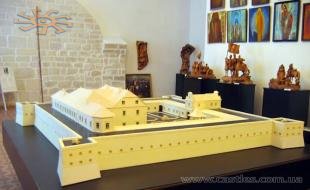 |
In place of the palace - orthogonal in plan – previously was the inner court. The palace is two-storied, with its characteristic forms of the Renaissance. The main entrance to the building is emphasized by the balcony on stone consoles. Casemate doors are also made in Renaissance forms.
Casemates of the castle are one-storeyed and were built around the perimeter of the court, with a space of 12 meters from the outer defensive walls. For the strengthening of the defensive capacity the gap between the defensive walls and casemates was filled up with the soil in the XVII century. The front of each casemate goes to court. Window and door apertures are framed with white hewn stone in Renaissance forms. The roofs are flat. Inner apartments are overarched. Since 1995, the casemates were included in the objects of the State Historical and Architectural Reserve of the town Zbarazh.
Entrance tower locates on the same axis as the main entrance to the palace. Pentahedral bastions are remained partially - at a height of the curtain. In each of them were tunnels which connected them with casemates and the castle courtyard. The castle remains not completely, because in 1840 General Bam built on the territory a sugar mill; this has hastened the decline of the building.
I advise tourists not to be satisfied with only a review of the museum - but go all around the whole complex – somewhere fragments of the walls and towers are remained. 
Castle walls formerly. Castle gates on the old postcard. The postcard with two looks of the castle. The castle gates again.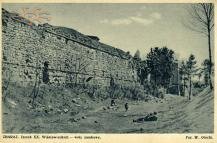 |
The postcard dated 1910 year. Rarity is again. :)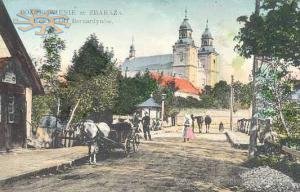 |
The grand cathedral is the main architectural dominant of the town, which can be seen almost from any point in the town. It is located on the 10 Nezalezhnosti Str.
Bernardins appeared in Zbarazh in 1627 at the invitation of the prince Jezhy Zbarasky, castellan of Krakow. He built for them a wooden monastery and began to build Roman Catholic Church and Monastery. His work continued Prince Janusz Koribut Wiśniowiecki with his wife Eugenia. In 1637 the princes Vishnevetska signed the act of establishing the monastery. During the Cossack wars the monastery remained but suffered very much. In those days monk and six priests were killed by Cossacks.
In 1675 Turks burned the church and killed three monks. Only in 1723 by Juzef and Stanislav Potocky was built grand Roman Catholic Church of St. Anthonio in Zbarazh, which remained till nowadays. The consecration of sanctuary was in August 2, 1755.

The monastery was built almost at the same time with a castle, but the complex remained till nowadays a bit in other form. In 1755 it was reconstructed in Renaissance and Baroque style. In the interiors has been applied so-called "illusory painting”. Partially are remained altars with sculptural decoration of the XVIII century (the author is A. Osinskyy), the fragments of mural painting of the end of the XVIII - XIX centuries. When we were there in 1999, the church was restored. From the paintings are preserved only fragments as from the great carved decoration of the monastery.
The monastery was one of the most influential in Podillya until Austro-Hungarian times (1785) when the establishment was "secularized" by the order of the emperor. At the monastery philosophical courses acted, provincial chapters held. From 1768 at the monastery was a hospital-shelter for the poor and ill, and from 1777 – a parochial school and Latin high school. There studied Ignacy Daszyński (politician, the prime of Lubelsky government in 1918, marshal of the Seym in 1928-1930) and the archbishop, bearer of the White Eagle Order Ignacy Tokarchuk. In 1924 the High School received the official status.
During the Ukrainian-Polish War in 1918-1920 monastery was damaged greatly, and in post-war period became a ruin in general.

Church of Assumption. 1758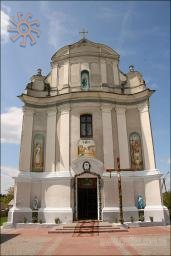 |
The bell tower (1746-1755, architect Johann Ganz) is a part of the Bernardine monastery complex. Is situated north of the church, is adjacent to the defensive walls surrounding the complex. Bell tower is made of stone and brick, orthogonal in the plan, double-deck, the facades are plastered with pilasters and divided by cornices. The windows are of arched and orthogonal shape. The pediment is crowned with a sculptural figure of the saint. The span roof has wooden constructions; the roofing is made of galvanized iron. In cellars are semicircular vaults. Unlike the church the bell tower was not damaged during the fire in 1788, and therefore remained its original Baroque form.
Bernardins returned to the town in 1990. Now are behind those times when in the Monastery were benches of military factory and in church was a depository of mineral fertilizers.
Now the church slowly obtains a normal shape, although its basements, they say, are still full of bones and skulls - whether it's "souvenirs" from the monks of past centuries, or from more recent victims of totalitarian regimes, it is difficult to say.
Not far from the church is situated an interesting in architectural plan Church of Assumption. In 1999 a disaster happened: several buildings in the center of Zbarazh sank through the earth. Landslides continue, endanger the old stone houses in the center.

Temples are the main architectural dominants of the town center. Bernardins built them one of the best, of course. The castle is not visible from here - at least at a time when the trees have leaves. Chapels also dominants, but rank is lower. The Bell Towers balance between these two categories.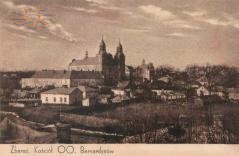 |
Strange broken sculptures are nearby bus station. Iconostasis of the Church of Assumption. Photos of church dated May 14, 2008. And the old postcard.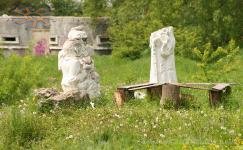 |
The look of the town on the beginning of the XX century. Zbarazh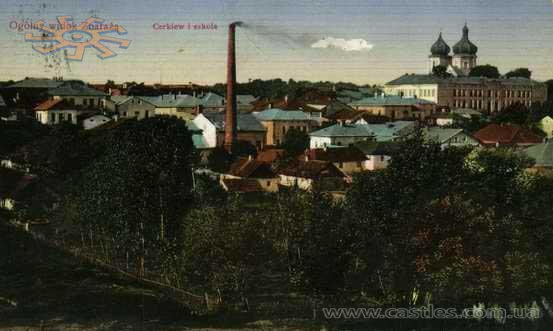 |
Roman Catholic Church in Zbarazh. 1923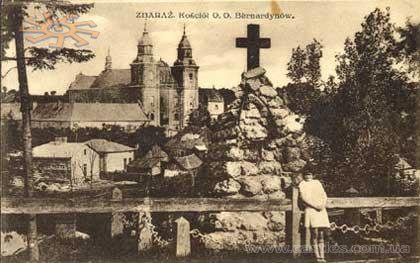 |
The exposition of the weapon in the castle’s casemates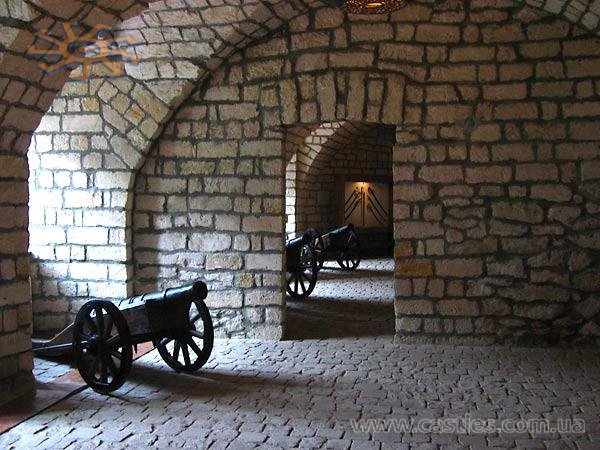 |
|
|

|

|
 |
|
"Замки і храми України" - некомерційний cайт, що підтримується фактично силами і ентузіазмом однієї людини. Допомогти проекту:
гривневий рахунок 4441 1111 4632 5091
євровий - 5168757402858452
Patreon
Ваш внесок допоможе не зневіритися в тому, що роблю вже 20 років. Дякую.
Екскурсійний супровід у мандрівці Кам'янцем-Подільським, Поділлям та Західною Україною в цілому: kamienczanka@gmail.com 
© All rights reserved.
Всі права на матеріали охороняються у відповідності до законодавства України.
Будь-яке використання матеріалів сайту можливе лише за попередньою узгодженністю |
Розробник 
|
|
|

